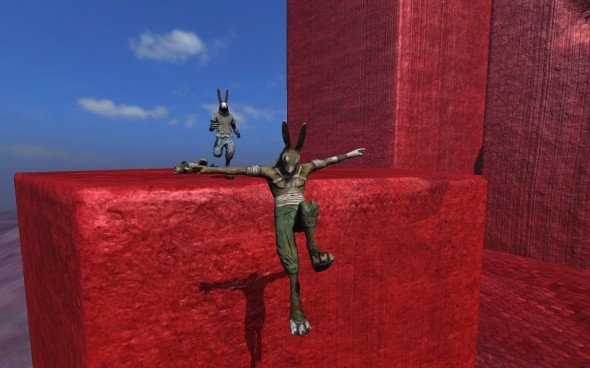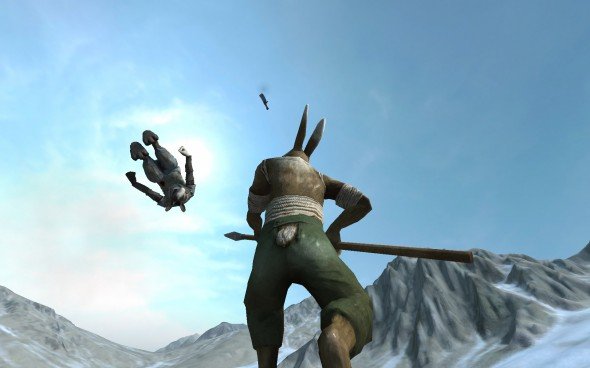Overgrowth preview

At the time of writing, the latest feature indie developers Wolfire have put into Overgrowth is the ability for weapons to slash open wounds in the characters they hit, from which blood spurts and trickles realistically down their clothing. But that's OK: they're rabbits.
This is a fighting game about bipedal animals kick-boxing and lacerating each other with knives in huge open levels. The animals aren't really the remarkable thing: the game is interesting for the fluid and physical way they connect with each other in combat. The game blends predetermined animations with physics, so that characters can be knocked about convincingly mid-roundhouse – and recover to do the same to you.
So, er, why are they rabbits again? “The game will have some really disturbing depictions of blood and pain,” says David Rosen, “and I don't know if I could handle doing that with human characters.”
That's not the only reason. As David says: “I suspect that audiences are hungry for novel experiences and settings, and would rather see something new than yet another game about masked ninjas.”

Overgrowth is in the alpha stage of development, and if you preorder it now you'll get the current version. It's still a proof of concept at the moment: a few arenas to choose from with a few opponents each, but no context for the fights except some spectacular scenery. It's hard to get a sense of what kind of game it'll be, so I asked David.
“This isn't final yet, but our plan is to have three categories of missions that you can choose – story, challenge and arena missions. The story missions focus on the characters in the world and how your actions affect them. The challenge levels are all about exploring the game mechanics and demonstrating your proficiency with them. The arena levels follow a professional entertainment fighter through his career, focusing on acquiring new abilities and equipment.”
The levels in the alpha are huge dramatic landscapes with weird stone relics and tall mountains. You can scamper across them with inhuman speed, leap huge distances, and even scramble up ledges and wall-run smoothly. There's a really slick 3D platformer in here somewhere.
Keep up to date with the most important stories and the best deals, as picked by the PC Gamer team.
Given that they're a small indie team making an ambitious game from scratch, is all this fancy engine stuff necessary?

“I didn't intend to make an engine,” David says. “I just wanted to make the game I had in my head, so I added one necessary component after another... eventually it all combined to form a pretty complex engine, but it's all designed specifically for this game.”
That means the various systems fit together seamlessly. “There's no shift between movement and combat modes,” David tells me. “You can smoothly jump out of a fight to wall-run up a wall at any time, without having to 'tear' yourself away from the combat system.”
That system is pretty simple: there's an 'attack' and a 'block' button, and the rest is all movement. David says it's about putting the complexity elsewhere.
“To attack in Overgrowth, you hold the left mouse to signal your intent, and then trigger the attack by moving within range of an enemy. This brings the focus up from low-level button presses to tactical positioning and awareness, and allows for fast and complex movement.”

Blocking prevents a blow from flooring you, but if it's powerful you'll still see your character reel from the physical force of it. Attacking after a successful block lets you throw your opponent, and duck-attacks sweep their legs from beneath them. The AI loves that one – I've lost a lot of fights where I try a roundhouse and they duck under it and trip me.
Fights end fast: one or two good blows can kill you, and even if they don't, you'll be lucky to get back on your feet before the AI kicks you to death. Or stabs you with the spear they picked up. The same goes for them, of course, so the instant you get in range of each other is critical.
I worry that it might be a little too fast right now: Wolfire's own videos of the game feature elegant exchanges of blocked and dodged blows that I've never come close to. But release is a long way off, and by letting preorderers play the game in development, they've got plenty of feedback to work from.
It's a big project: they've been working on it for three years and expect it to take one or two more. But we're talking about it now because it's starting to take shape: the movement is fluid and the combat is fun. There's still no 'game' to it in the broader sense – if you're only interested in how the current build plays, Overgrowth probably isn't worth the $30 preorder yet. But if you want to follow its development into a proper game, now is a good time to get involved.

